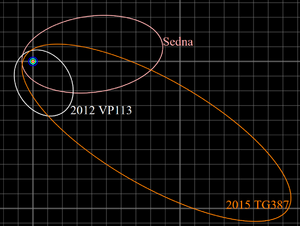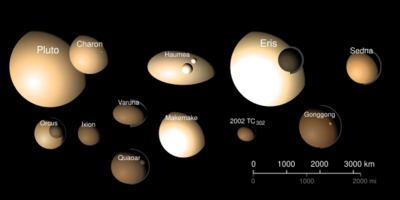Astronomy:2015 TG387
 2015 TG387 has an elongated orbit (at lower right); it has the greatest aphelion of the three known sednoids | |
| Discovery [1][2] | |
|---|---|
| Discovered by | |
| Discovery date | October 13, 2015 |
| Designations | |
| 2015 TG387 | |
| V302126[3] | |
| Minor planet category | TNO · E-SDO · sednoid |
| Orbital characteristics [4] | |
| Epoch 2018-Mar-23 (JD 2458200.5) | |
| Uncertainty parameter 4 | |
| Observation arc | 949 days (2.60 yr) |
| |{{{apsis}}}|helion}} | 2037 AU |
| |{{{apsis}}}|helion}} | 64.8 AU |
| 1051 AU | |
| Eccentricity | 0.94 |
| Orbital period | 34080 years |
| Mean anomaly | 359.4° |
| Mean motion | 0.00002892°/day |
| Inclination | 11.66° |
| Longitude of ascending node | 300.90° |
| 118.3° | |
| Physical characteristics | |
| Dimensions | ~300 km (190 mi)[5] |
| Absolute magnitude (H) | 5.3[4] |
2015 TG387 (also known under its provisional designation V302126,[3] nicknamed The Goblin for the letters TG and because its discovery was near Halloween),[6][7] is a trans-Neptunian object and sednoid in the outermost part of the Solar System.[8] It was first observed on October 13, 2015, by astronomers David J. Tholen, Scott S. Sheppard, and Chad Trujillo with the Subaru Telescope at Mauna Kea Observatories, and publicly announced on October 1, 2018.[2][9]
Physical characteristics
2015 TG387 is estimated to be 300 km (190 mi) in diameter.[5] A precise size estimate is difficult to determine due to its faintness, comparable to one of Pluto's smaller moons (24th magnitude in the late 2010s when it was identified).[10] The current size estimate is based on assumptions about 2015 TG387's albedo: if it is a darker object then it would also have to be larger; a higher reflectivity would demand that it be smaller.[11]
By observing 2015 TG387's color and apparent brightness, in combination with various methods and other known data about Trans-Neptunian objects, it is possible to develop a model based on the predicted size, reflectivity, and spectrum:
Sedna, another body hundreds of AU from the sun, is relatively dark and red compared to icy bodies, which tend to be brighter and whiter.[12] One way to understand TG387 is to compare observations in the infrared and visible light with a telescope using a spectrometer.[13]
Orbit
2015 TG387 is the third sednoid to be discovered, following 90377 Sedna and 2012 VP113.[5][14]
Implications of orbit
Along with the similar orbits of other distant trans-Neptunian objects, the orbit of 2015 TG387 suggests, but does not prove, the existence of a hypothetical Planet Nine in the outer Solar System.[5][9]
(As of 2018), the object is 80 AU from the Sun; about two-and-a-half times farther out than Pluto's current location.[7] As with Sedna, it would not have been found had it not been on the inner leg of its long orbit. This suggests that there may be many similar objects, most too distant to be detected by contemporary technological methods. Following the discovery of 2015 TG387, Sheppard et al. concluded that it implies a population of about 2 million inner Oort cloud objects larger than 40 km (25 mi), with a combined total mass of 1×1022 kg, which is several times the mass of the asteroid belt.[5]
Visualizations
View of 2015 TG387 from earth, showing retrograde loops every year, with current position near γ Pegasi
See also
- List of Solar System objects most distant from the Sun in 2018
- List of Solar System objects by greatest aphelion
References
- ↑ "2015 TG387". Minor Planet Center. https://www.minorplanetcenter.net/db_search/show_object?object_id=2015+TG387. Retrieved 10 October 2018.
- ↑ 2.0 2.1 "MPEC 2018-T05 : 2015 TG387". IAU Minor Planet Center. October 1, 2018. https://www.minorplanetcenter.net/mpec/K18/K18T05.html. Retrieved October 2, 2018.
- ↑ 3.0 3.1 Trujillo, C.; Sheppard, S.S.; Tholen, D.J.; Kaib, N. (24 October 2018). "A New Inner Oort Cloud Object". 50th annual meeting of the AAS Division of Planetary Sciences. abstract 311.09. https://aas.org/meetings/dps50. Retrieved 19 October 2018.
- ↑ 4.0 4.1 "JPL Small-Body Database Browser: (2015 TG387)". Jet Propulsion Laboratory. https://ssd.jpl.nasa.gov/sbdb.cgi?sstr=3830896. Retrieved October 2, 2018.
- ↑ 5.0 5.1 5.2 5.3 5.4 Sheppard, Scott; Trujillo, Chadwick; Tholen, David; Kaib, Nathan (September 28, 2018). "A New High Perihelion Inner Oort Cloud Object". arXiv:1810.00013 [astro-ph.EP].
- ↑ Guarino, Ben (October 2, 2018). "New dwarf planet spotted at the very fringe of our solar system". The Washington Post. https://www.washingtonpost.com/science/2018/10/02/new-dwarf-planet-spotted-very-fringe-our-solar-system. Retrieved October 3, 2018.
- ↑ 7.0 7.1 Chang, Kenneth (October 2, 2018). "A Goblin World That Points Toward Hidden Planet Nine in the Solar System". The New York Times. https://www.nytimes.com/2018/10/02/science/goblin-planet-nine.html. Retrieved October 2, 2018.
- ↑ Mortillaro, Nicole (October 2, 2018). "Discovery of new object supports theory of 'super-Earth' at edge of solar system". CBC News. https://www.cbc.ca/news/technology/planet-nine-tg387-1.4845760. Retrieved October 2, 2018.
- ↑ 9.0 9.1 Witze, Alexandra (October 1, 2018). "'Goblin' world found orbiting at the edges of the Solar System". Nature. doi:10.1038/d41586-018-06885-1. https://www.nature.com/articles/d41586-018-06885-1. Retrieved October 2, 2018.
- ↑ "New object beyond Pluto hints at mysterious 'Planet X'". 2018-10-02. https://www.nationalgeographic.com/science/2018/10/news-solar-system-object-pluto-planet-x-sun-space/.
- ↑ "New object beyond Pluto hints at mysterious 'Planet X'". 2018-10-02. https://www.nationalgeographic.com/science/2018/10/news-solar-system-object-pluto-planet-x-sun-space/.
- ↑ [1]
- ↑ [2]
- ↑ "JPL Small-Body Database Search Engine: a > 150 (AU) and q > 50 (AU) and data-arc span > 365 (d)". JPL Solar System Dynamics. http://ssd.jpl.nasa.gov/sbdb_query.cgi?obj_group=all;obj_kind=all;obj_numbered=all;OBJ_field=0;ORB_field=0;combine_mode=AND;c1_group=ORB;c1_item=Bh;c1_op=%3E;c1_value=150;c2_group=ORB;c2_item=Cj;c2_op=%3E;c2_value=365;c3_group=ORB;c3_item=Bi;c3_op=%3E;c3_value=50;table_format=HTML;max_rows=100;format_option=comp;c_fields=AcBhBgBjBkBlBiBnBsCjCpAiBq;.cgifields=format_option;.cgifields=combine_mode;.cgifields=ast_orbit_class;.cgifields=obj_kind;.cgifields=table_format;.cgifields=obj_group;.cgifields=obj_numbered;.cgifields=com_orbit_class&query=1&c_sort=BiA. Retrieved October 2, 2018.
See also
- List of Solar System objects by greatest aphelion
External links






